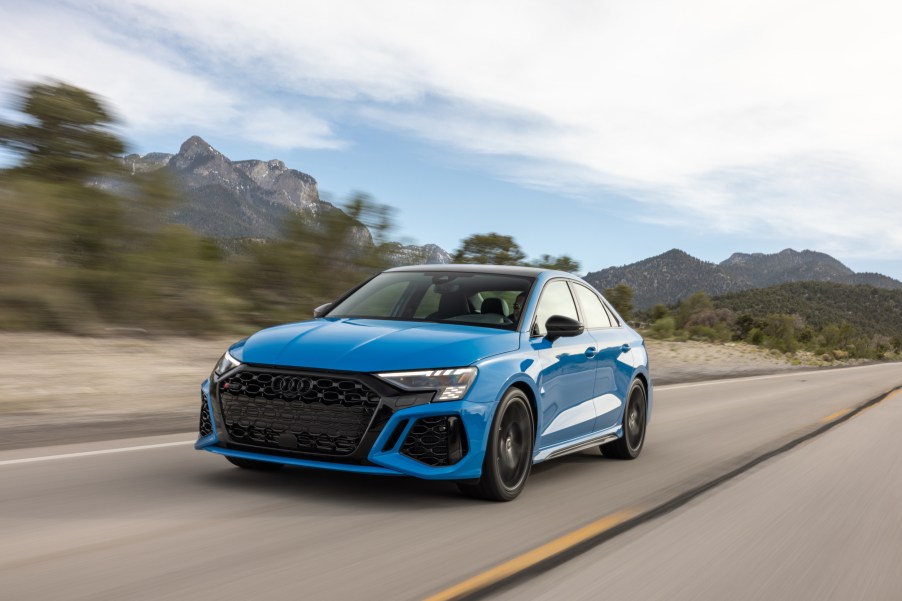
Do You Know What Torque Vectoring In a Car Is?
Torque vectoring is a term you hear tossed around regarding performance cars. Essentially a traction control system, it’s designed to manage grip and improve handling in all weather conditions. But what is torque vectoring? And, does it really provide an advantage? To answer these questions, let’s take a closer look at torque vectoring. We’ll also take a look at the different types of torque vectoring systems, and the cars that use it.
What is torque vectoring?

Torque vectoring redistributes torque between the drive wheels to improve traction and stability, reports J.D. Power. By using speed sensors in the wheels, the system can vary the amount of torque applied based on the level of traction or wheel slippage detected. If a sensor detects that one wheel is spinning faster than the others, the torque vectoring system will alter the vehicle’s handling to improve cornering.
The concept is similar to how a differential manages the drive wheels. As a vehicle travels in a straight line, the wheels on both sides of the car rotate at the same speed. However, when a vehicle makes a turn, the outer wheels start to turn faster. This is because they have to cover a greater distance than the inner wheels.
There are several ways to manage torque, so it’s applied evenly and predictably. The torque vectoring system can reduce the torque applied to the inside drive wheel. It can also increase the torque applied to the outside wheel. This leads to improved yaw control around the vehicle’s axis. Both improved traction control and yaw control lead to better cornering and stability at high speeds or on low traction surfaces.
The different types of torque vectoring in a car
Several types of torque vectoring in a car include differential-based torque vectoring, brake-based torque vectoring, and electric-based torque vectoring.
Brake Torque Vectoring: A brake-based system is the simplest, most inexpensive type of torque vectoring. Utilizing the anti-lock braking and stability control systems, it applies the brakes to the wheels when it detects wheelspin. This approach allows individual control of all four wheels without needing a more complex, dedicated torque vectoring system.
The downside to this type of system is additional wear on the brakes, reports NAPA. This makes it less than ideal for high-performance applications. This drawback is minimal for most people but can result in slower lap times on racing cars. Increased brake wear can lead to brake fade and longer stopping times on a race course.
Differential Torque Vectoring: Differential torque-vectoring systems use an open differential combined with clutch packs on either side of the vehicle. The clutch packs are inactive when the vehicle is traveling in a straight line or has full traction applied to all wheels. However, when one side starts to slip or speed up, the system engages the clutch packs. It does this to increase or reduce the torque to compensate.
This type of torque-vectoring is most often used with all-wheel drive (AWD) vehicles. Using a differential torque-vectoring system with AWD can not only shift power and traction from the left or right side of the vehicle but from the front wheels to the back wheels. Or it can make adjustments to the wheels individually as needed.
Electric torque vectoring is common in electric cars
A less common form of torque vectoring, but one prevalent in electric vehicles, is electric torque vectoring. This system is similar to the other forms of torque vectoring. However, this system uses the vehicle’s electric motors to adjust the power to each wheel. The benefits of this system include faster, more responsive application of torque vectoring and individual control to send up to 100% of available torque to one or more wheels.
What cars use torque vectoring?
Differential torque vectoring is most often found on high-performance cars like BMWs, Acuras Porsches, Audis, and Lexus. It also appeared on cars with a rally heritage. This includes the Mitsubishi Evo, Subaru WRX, VW Golf, Ford Focus RS, and Hyundai Veloster i30 N.
Brake-based torque vectoring systems are found on Nissan, Toyota, and Subaru models. Finally, high-end electric vehicles by Tesla and Rivian have started equipping their vehicles with electric torque vectoring systems.
Why is torque vectoring an advantage?
For 99% of drivers, torque vectoring is extremely good because it improves traction and stability in all weather conditions. In fact, it rivals the invention of antilock brakes as an effective safety system. However, unlike antilock brakes where you feel the brake pedal pulsing, most torque vectoring systems are unobtrusive, and you’ll barely know they are there.
During performance driving, torque vectoring offers several advantages by putting the power down where it’s needed and tightening the line through corners. Smoothness and consistency are key when driving on a track or closed road course. A good differential torque vectoring system enhances those traits by improving overall speed and lowering lap times.



